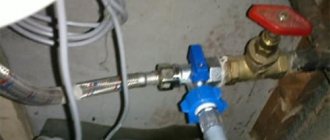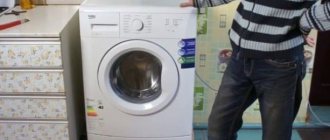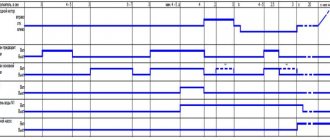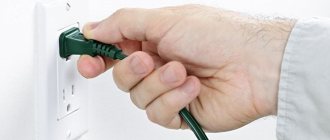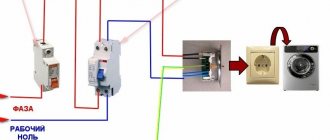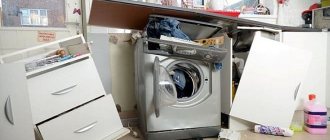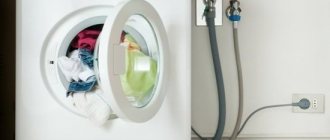The electrical system carries a great deal of potential danger, so prudent users strive to take measures to minimize the risk of electric shock. Residents of Soviet-built houses are interested in how to ground a washing machine if there is no grounding. There are several ways to protect yourself and your family. The most correct one is to install an RCD.
The need to ground the washing machine
In any electrical appliance, destruction of the insulation of live parts can occur, which will lead to a phase short circuit to the housing. This happens due to the natural aging of the polymer sheath of the wires, overheating and other reasons.
Often, electrical potential accumulates on the housing without compromising the integrity of the insulation. It is induced by electromagnetic fields from a motor and a pump.
Grounding the housing and other non-current-carrying metal elements ensures that the electrical potential is zeroed.
We are looking for a connection option
In old houses equipped with out-of-date electrical communications, you can organize the grounding of an automatic machine in several ways. So, the main options for grounding the unit:
- preparation of a separate electrical point connected to the electrical panel with grounding;
- RCD connection;
- connecting the machine body to house utilities or heating radiators;
- organization of a potential equalization system for household appliances;
- development of a personal grounding loop (relevant for private homes).
The method that involves connecting the ground wire to a water or sewer pipe is very effective, but has several significant drawbacks. Firstly, this can lead to rapid wear of the pipe, emergency leakage, and, as a result, flooding of the neighbors below. The same fate awaits heating radiators. Secondly, this method is prohibited by electrical safety rules, so it is better not to use it in practice.
Possible consequences of missing ground wire
High potential on the device body threatens the following:
- electrical injury to the user;
- reducing the service life of the device.
The first consequence is the most important. If a live part is touched, current will flow through the user. Its value depends on the quality of the electrical contact between a person and the grounded structures of the building.
In this regard, washing machines and other appliances operated in conditions of high humidity are especially dangerous. Water is a conductor of electricity, and a person standing on a damp floor will receive a stronger shock than in a dry room.
We must not forget about one more circumstance. The body of the washing machine is in electrical contact with the pipes and mixer through the water. The user may receive electrical injury without even touching the device. For example, a man standing in the bathtub was electrocuted at the moment when he pulled the plug out of the drain hole. Flows of water from the washing machine and sanitary ware met in the sewer, and the phase in the device was shorted to liquid. This is a real life incident.
If the case is connected to ground, then the electric current, instead of the human body, will follow the path of least resistance, i.e. into the ground.
Let us recall the theory
Many users do not even think about such a problem as grounding and quietly operate the equipment for many years, not suspecting that they are exposing their loved ones to the danger of electric shock. Only after receiving a noticeable blow, having simultaneously touched the body of the machine and the mixer in the kitchen or bathroom, do they begin to understand that grounding saves everyone living in the apartment from such danger.
The main reasons for urgently establishing grounding are as follows:
- Huge risk of electrical injury - you may just feel a slight tingling sensation at first, but this is already considered a very alarming signal.
- There is an opinion, confirmed by professional electricians with extensive experience, that in the absence of grounding, all built-in electronics may fail before the warranty expires. Delicate parts do not tolerate the accumulation of static charge: you will face quite expensive repairs, and sometimes you will have to buy a new washing machine.
You shouldn’t wait for something to burn out or for someone close to you to get an electric shock—everything needs to be done on time.
If light bulbs in your apartment often start to burn out after you purchased a washing unit, this is the first call, you need to urgently do grounding.
Before doing grounding with your own hands, carefully examine the household appliances for the integrity of the insulation protection of the connection wire, and whether there are any frayed wires inside. Very often, the cause of electric shock can be damaged insulation, so grounding will not solve all problems.
If you live in a house with stationary electric stoves, then there is already grounding - the third wire is responsible for this. Therefore, you are lucky and do not need to do anything.
Basic methods
There are several ways to protect yourself. The choice depends on how the grounding system in the house is organized.
Through the electrical panel
In post-Soviet houses, grounding is arranged according to the TN-S scheme. The distribution board has a special PE busbar for connecting the protective conductor. On the other hand, it is connected to the third contact of the socket or a bolt on the body of the washing machine.
In Soviet-built houses, the TN-C system is implemented, which does not provide grounding. But at some sites it was improved to the TN-CS level. Here, PE busbars are also installed in the switchboards.
Rules for grounding a washing machine with your own hands
Before work, prepare the following tools:
- phase indicator (indicator screwdriver);
- multimeter;
- wire cutters;
- screwdrivers with Phillips and flat blades.
The procedure depends on the type of residential property.
In the apartment
In new buildings they operate in the following order:
- Knock out a hole for an outlet in the wall next to the machine.
- They punch a groove to it from the junction box.
- A 3-core wire with a cross-section of 2.5 square meters is laid in the furrow. mm.
- Connect conductors to each of the 3 contacts of the socket.
- Turn off the input circuit breaker and connect the wires to the corresponding terminals in the distribution box or panel.
- Check the functionality of the system.
- They turn off the power to the apartment again and complete the installation of the electrical point, then seal the groove with cement mortar.
If the supply line is drawn from the switchboard, the protective conductor is closed to the PE bus.
In a private house
In the private sector, the TN-S system is not used due to its high cost, TN-CS - due to the vulnerability of the line between the consumer and the substation (there is a high probability of a neutral break above the point of splitting of the combined conductor into protective and neutral). Instead, the TT type is in use here, which involves installing its own ground electrode for each house.
The design consists of 3 electrode rods, which can be used as:
- pipes with a diameter of 3–5 cm with a wall thickness of 3.5 mm;
- strip steel or angle with a thickness of 4 mm;
- rod with a diameter of 10 mm.
The length of the pins is selected so that when deepened they sink at least 30 cm below the freezing mark of the soil. However, they cannot be shorter than 1.5 m.
Sequencing:
- Dig a hole 0.5 m deep.
- The electrodes are cut obliquely with a grinder to sharpen the end, and driven into the bottom of the recess at a distance of 1.2 m from each other (at the vertices of an equilateral triangle).
- A steel strip is welded to the shanks protruding from the ground, combining the rods into a single structure.
- Connect a current conductor - a strip or cable 5 mm thick - to the ground electrode.
- They bring it into the house and connect it to the PE bus.
- They fill up the trench.
Next, connect the devices in the house to the PE bus as described in the previous section.
In Khrushchev
Most Khrushchev buildings use the TN-C system, which means there is no PE bus. It is recommended to install an RCD at the entrance to the apartment. The phase and neutral from the meter are connected to the upper terminals, the wires to the apartment are connected to the lower terminals.
In order for the RCD to be triggered immediately after a phase is shorted to the housing, before the user touches it, the washer is reset to zero. The protective conductor is connected to the neutral above the residual current switch.
Ground Wire Colors
Color marking of cable cores helps reduce the likelihood of errors during electrical installation work.
It is customary to connect:
- conductor in red, white, brown or black insulation - to the phase;
- in blue - to neutral;
- in yellow-green - to grounding.
Marking makes it easier to find the desired core in the distribution box. But if the master did not lay the wires personally, you should not trust her. The phase is found using an indicator screwdriver.
To distinguish grounding from neutral, proceed as follows:
- Switch the multimeter to the mode for measuring alternating voltage (ACV or “~”) up to 650 or 700 V (depending on the model of the device).
- One probe touches the phase, the other touches the other 2 cores in turn.
- The conductor on which the device showed a higher value is marked as neutral, the other as “ground”.
Having figured out the purpose of the cores, you need to turn off the power to the apartment and only after that start making connections.
Through the electrical panel
It is better to ground washing equipment through a stationary electrical panel - it is effective and civilized. To do this, you need to install a separate specially shaped socket for the machine, and the three-core wire will go to the panel, where it will be connected to ground.
To perform the work you need to prepare a simple set of tools:
- probe with indicator;
- pliers with insulators on the handles;
- a special tool for stripping wire ends or a sharp knife;
- duct tape and a supply of enthusiasm.
All conductors need to be connected only to the place corresponding to them - two bus bars and a special switch operating in automatic mode.
Safety precautions for carrying out electrical work are based on real cases, sometimes with fatal consequences, so you should not neglect them.
Grounding is not considered a difficult task, but if you are unfamiliar with the basics of electrical appliances and similar networks, then it is better to seek the help of a professional electrician. The financial costs will be small, but the safe use of household appliances is guaranteed 100%.
When working independently you need to know:
- On any standard electrical panel there are two buses - neutral (N) and ground (PE), only make wiring from them.
- Having made the necessary wiring, you need to connect the wire in this way: we connect the blue one to the N bus, the red one through the RCD to the meter phase, and the yellow-green color to the PE bus.
Remember that this particular method of grounding is done legally and is extremely reliable.
Common Mistakes
Most often, home craftsmen make the following mistakes:
- They start work without first drawing a diagram. This significantly increases the likelihood of error.
- They take on electrical installation without having sufficient experience in this field. Any mistake can cause an electric shock, so it is better to turn to professionals.
- Connect the wires by twisting. This method is not suitable for heavy network loads. It is necessary to use crimp sleeves, clamps or terminals.
- Use thin wires. The washing machine is an energy-intensive consumer with a power of 2.5–3 kW. To power it, it is better to use a cable with a cross-section of at least 2.5 square meters. mm.
- They do not pay attention to the rating of the socket and terminals. The products must withstand the same current as the circuit breaker protecting the line.
- They forget to perform control measurements after installation. The test consists of determining the resistance of the phase-zero loop and the insulation of the conductors.
FAQ
Question No. 1. Do you need to install a separate RCD for your washing machine?
Installation of a protection device is mandatory. The “washing machine” is a device that consumes a large amount of electricity and operates under heavy loads. The RCD will protect against fires and damage to electrical equipment.
Question No. 2. Why does the protective module trigger when starting the wash?
Possible reasons:
- a voltage signal pulse occurred in the network;
- errors during installation of protection;
- the heating element or the controlled unit does not work.
Question No. 3. How to choose an automatic washing machine?
Criterias of choice:
- operating power;
- voltage;
- technical characteristics of the protection device;
- operating current value.
Question No. 4. What does an RCD consist of?
- body made of plastic;
- current pulse converter;
- switch;
- module that performs self-testing of operation.
Useful tips and general recommendations
Before work, check the phase indicator on a conductor or terminal known to be connected to the current source. If there is little space in the distribution board, purchase a socket RCD.
The rated amperage of the residual current circuit breaker must be one step higher than that of the circuit breaker protecting it. If this condition is met, the device will be protected from operation in overload mode.
If the RCD is triggered falsely due to large leaks in the old wiring, instead of a 10 mA device, install a 30 mA analogue.
After connecting the wire to the terminal of the socket or distribution box, pull it to check that it is securely fastened.
In the bathroom, sockets with a dust and moisture protection class of at least IP44 are installed. The minimum height above the floor is 30 cm.
